Analytical Instrumentation In Life Science Market Size
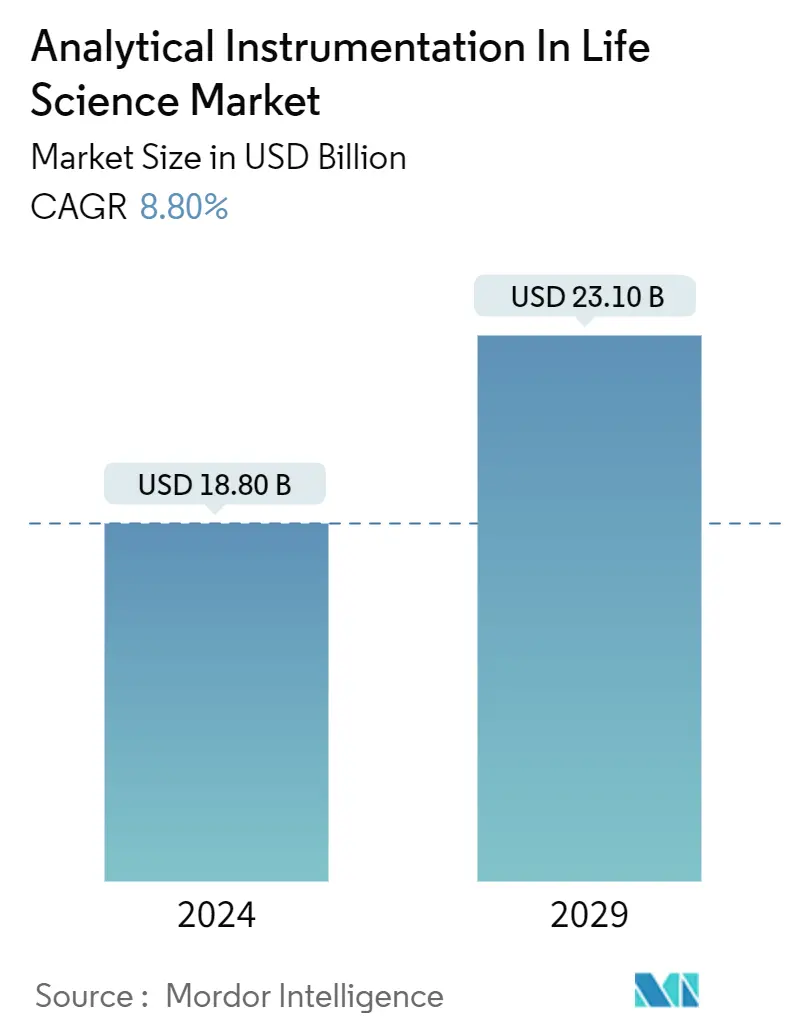
| Study Period | 2019 - 2029 |
| Market Size (2024) | USD 18.80 Billion |
| Market Size (2029) | USD 23.10 Billion |
| CAGR (2024 - 2029) | 8.80 % |
| Fastest Growing Market | Asia Pacific |
| Largest Market | North America |
Major Players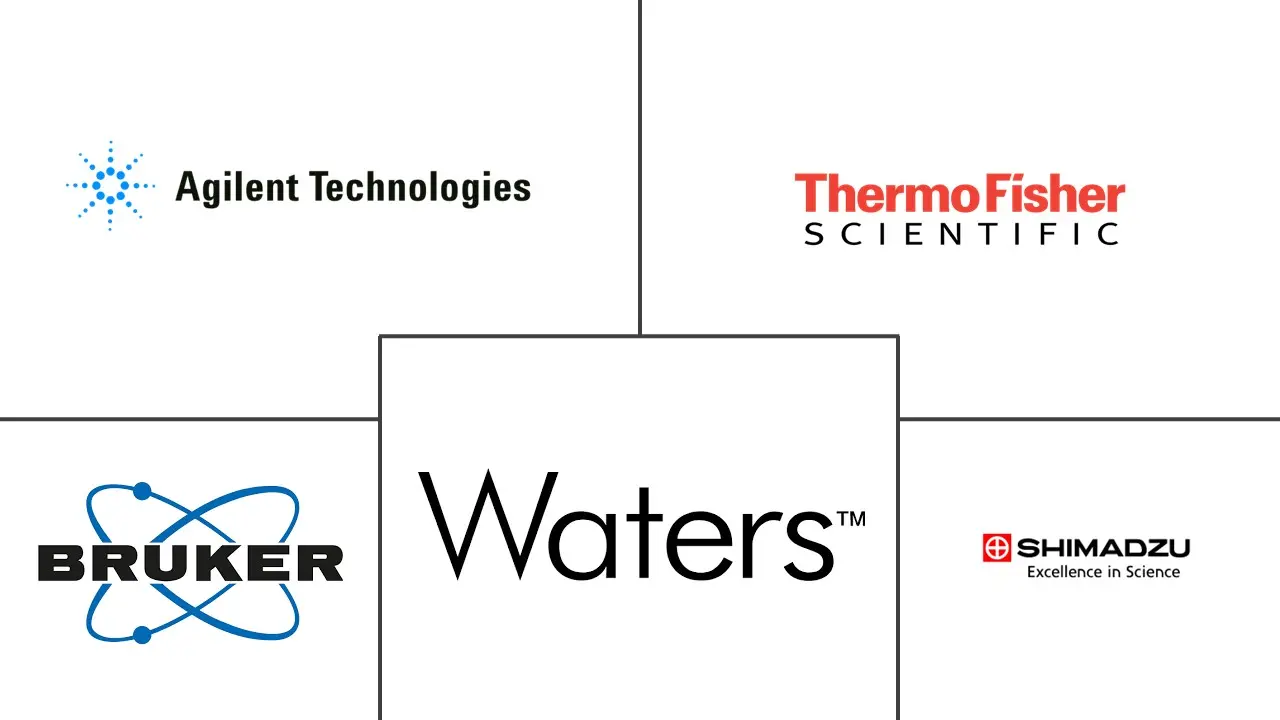
*Disclaimer: Major Players sorted in no particular order |
Analytical Instrumentation In Life Science Market Analysis
The Analytical Instrumentation In Life Science Market size is estimated at USD 18.80 billion in 2024, and is expected to reach USD 23.10 billion by 2029, growing at a CAGR of 8.80% during the forecast period (2024-2029).
The increasing number of chronic diseases and viruses across developing and developed regions fuels the demand for analytics instrumentations in pharmaceuticals, medical devices, and biotechnology companies.
- The emerging diseases and viruses worldwide demand new medicines, creating new market opportunities for analytical instruments such as gas and liquid chromatography. These methods help professionals to identify a molecule with remedial properties. Similarly, it helps to analyze the existing medicines and alter the formulations to reduce side effects and improve results.
- The need to correctly analyze the chemical components in the drugs to accurately understand the number of ingredients and purity of the product increased the demand for gas chromatography across the pharmaceutical industry. Gas Chromatography helps in quality control for drugs before launching them. Drug manufacturers must follow the rules and regulations while developing drugs and need to prove their safety to regulatory agencies such as FDA. Thus, chromatography is gaining traction across drug manufacturing companies.
- The growing investment in the research and development of medicines, drugs, and vaccines contributes to market growth. For instance, in July 2022, the Department of Pharmaceuticals India set up 7 National Institutes of Pharmaceutical Education & Research (NIPERs) to foster and encourage quality and excellence in pharmaceutical research and education. An expenditure of INR 1,500 Crore (USD 183.42 million). Approved by the government to strengthen or upgrade these NIPERs for the period 2021-22 to 2025-26.
- The growing number of chronic diseases such as cancers, heart and lung infections fuels the drug demand worldwide. Government agencies such as the National Cancer Institute (NCI), medical research universities, and pharmaceutical companies are focusing on drug discovery and drug development. The growing spending on pharmaceuticals across U.S., Germany, Canada, and other countries creates demand for medicines and pharma products and is projected to boost the demand for analytical instrumentation.
- The COVID-19 pandemic forced the world population to stay at home, and lockdowns across the countries postponed the ongoing clinical trials and shifted focus towards vaccine trials and research and development on coronavirus. The supply chain disruption halted the production of instruments during the initial phase of the pandemic. The growing number of tests, vaccine trials, and R&D increased the demand for analytical instrumentation in the life science industry. The demand for medicines and drugs increased exponentially during the pandemic, accelerating market growth in the second half of 2020.
Analytical Instrumentation In Life Science Market Trends
Pharmaceutical Industry to Grow with Significant Growth Rate
- The various types of gases such as nitrogen (N2), oxygen (O2), carbon dioxide (CO2), or a combination of gases are used in pharmaceutical packaging such as liquid vials, injection vials, lyophilized vials, and pouches to store medicated patches. The gas over the sample enables to extend the product's shelf life. Thus, monitoring the gas content is very important in pharma companies to ensure that content doesn't exceed the limits.
- A mass spectrometer uses precise techniques to deliver a sample's molecular information. These machines help ionize molecules to compute the masses and ratios of peptides, isotopes, and other compounds for drug development and discovery. The data gathered by the spectrometer helps to promote innovative pharmaceutical research.
- Similarly, the rising adoption of Chromatographs across the pharma industry drives segment growth. Analytical chromatography is a vital method to identify chemical mixtures and their proportions. Furthermore, liquid chromatography is widely accepted for pharmaceutical development and discovery as it is rapid, simple, and accurate. Further, the proliferation of automated liquid analytical instruments in the pharma industry reduces human errors and streamlines the data efficiently.
- The growing pharmaceutical industry in India will likely further create demand for analytical instrumentation. Major pharmaceutical companies established research and development centers in India that encourage industry growth. For example, Pfizer's research and development center in Chennai focuses on drug development and discovery, and Novartis' Hyderabad center is developing novel drugs and plans to invest USD 100 million in the center.
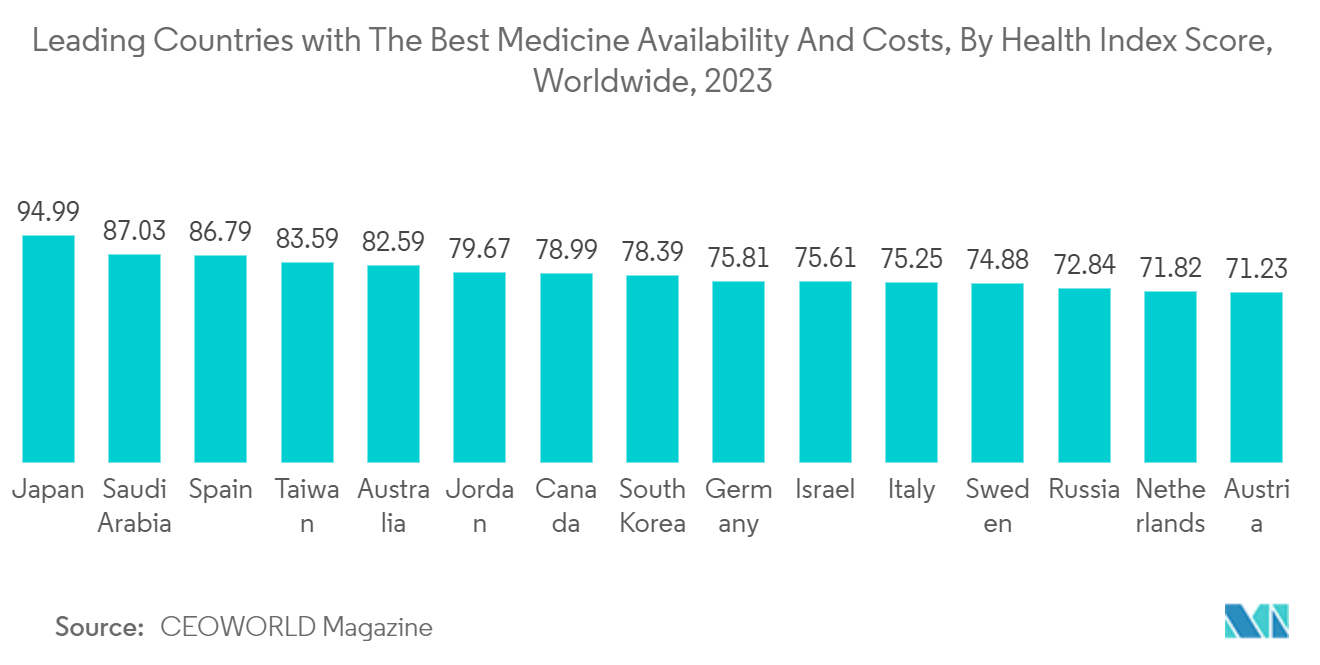
Asia-Pacific is Expected to Witness Significant Growth
- Asia-Pacific is expected to register the highest CAGR during the forecast period owing to the rapid development of the healthcare and life science industry, government support for domestic manufacturing, and increased funding in research and development.
- The integration of advanced technologies across analytical instrumentation creates new market opportunities. For instance, in July 2022, Agilent launched two new products from its mass spectrometry (MS) and gas/liquid chromatography (GC/LC) product lines at Future Lab Summit in India. These instruments are combined with the latest technologies, such as artificial intelligence (AI) and machine learning(ML), with higher sensitivity and accuracy. The new equipment is expected to help customers modernize lab analytics and improve lab productivity with minimum downtime.
- According to India Brand Equity Foundation (IBEF), India's domestic pharmaceutical market is expected to reach over USD 120 billion by 2030. The huge pool of scientific talent, strong educational system, favorable regulatory environment, supportive government policies, and low operating costs made the country an attractive destination for drug discovery and development, commercial manufacturing, and clinical trials.
- Further, Asia is emerging as a pharmaceutical research and development hub due to growing research and development investments in India, China, and Japan. For instance, in August 2022, BioDuro-Sundia, a commercial service contract research development and manufacturing organization and X-Chem, launched the DNA Encoded Compound Library (DEL) technology services to quickly help Chinese pharmaceutical companies discover small molecule drugs. Such technological advancement is expected to fuel market growth in the region.
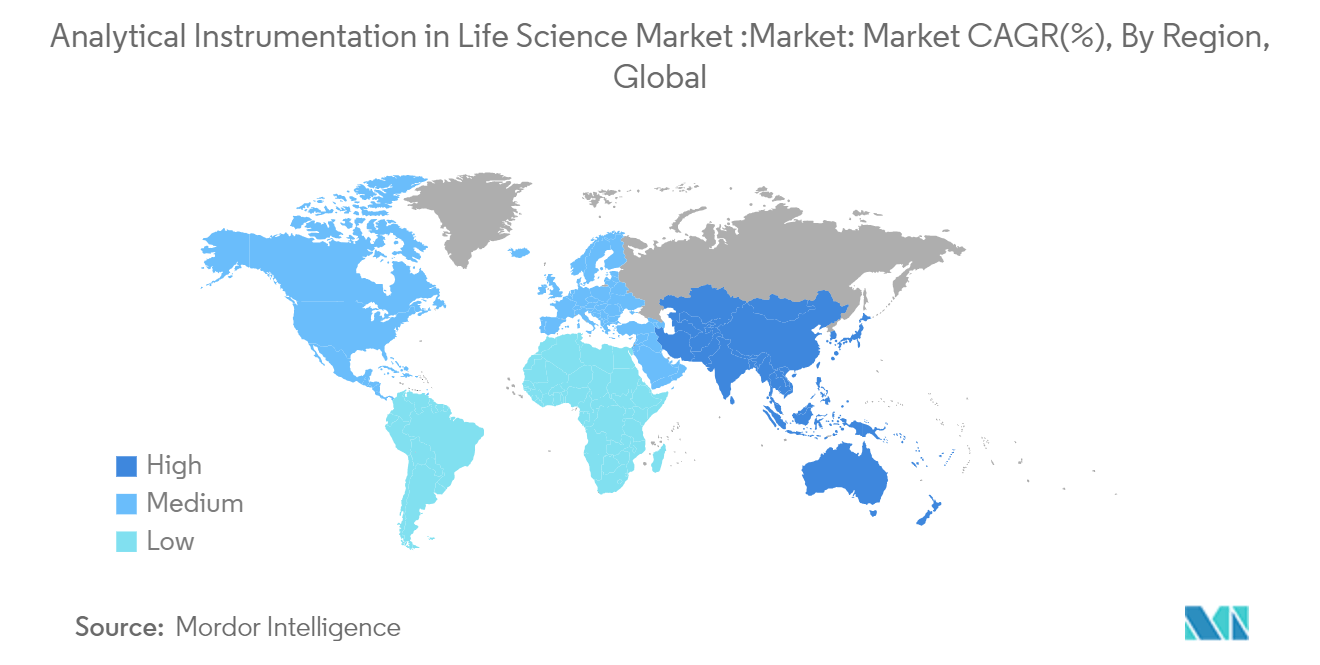
Analytical Instrumentation In Life Science Industry Overview
The global analytical instrumentation market for the life sciences industry appears semi-consolidated. With the rise in chronic diseases and increased government investments in R&D programs across countries, the major market players focus on developing new products and enhancing existing product features.
- January 2023 - Bruker Corporation and Switzerland-based Biognosys AG announced a strategic collaboration to widen access to Biognosys 's CRO services. The partnership is expected to help in disease biomarker discovery, proteomics research, clinical trials, drug discovery, and development.
Analytical Instrumentation In Life Science Market Leaders
-
Agilent Technologies
-
Thermo Fisher Scientific
-
Waters Corporation
-
Bruker Corporation
-
Shimadzu Scientific
*Disclaimer: Major Players sorted in no particular order
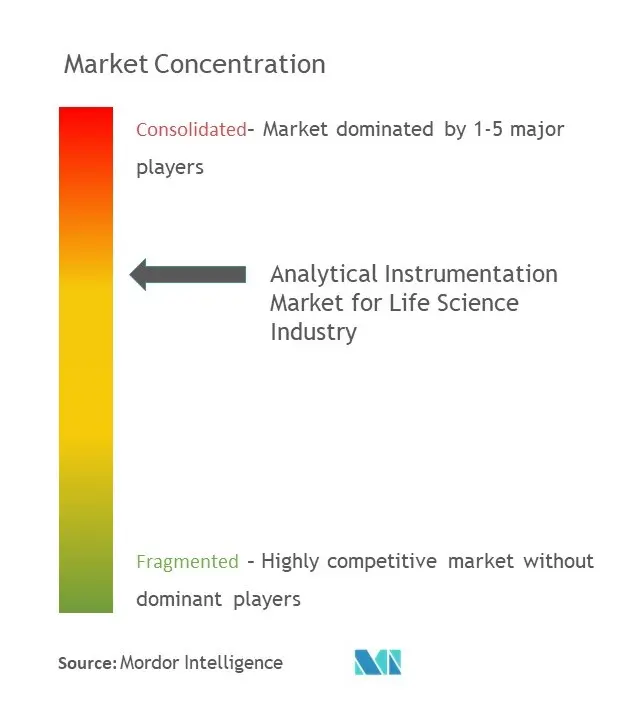
Analytical Instrumentation In Life Science Market News
- March 2023 - The COVID-19 pandemic increased investment in India's healthcare infrastructure and research and development. The government of India announced in Budget 2022 that the country focused on building a national digital health ecosystem. In Union Budget 2023, the Government of India announced a new pharmaceutical program and further collaborations for private and public medical faculties and private research and development teams.
- March 2023 - The UK's life sciences manufacturing projects received GBP 277 million (USD 350.19 million) investment from government and private investment. The government's Life Science Vision aims to create a globally competitive environment for life science manufacturing.
Analytical Instrumentation In Life Science Market Report - Table of Contents
1. INTRODUCTION
- 1.1 Study Assumptions and Market Definition
- 1.2 Scope of the Study
2. RESEARCH METHODOLOGY
3. EXECUTIVE SUMMARY
4. MARKET INSIGHTS
- 4.1 Market Overview (Current Scenario of Analytical Instrumentation in lifesciences industry and KPI Analysis)
- 4.2 Technological Trends
- 4.3 Supply Chain Analysis
- 4.4 Impact of macro trends (post-COVID-19 scenario, supply chain disruptions, and economic uncertainties among others) on the Market
-
4.5 Industry Attractiveness - Porter's Five Forces Analysis
- 4.5.1 Bargaining Power of Buyers/Consumers
- 4.5.2 Bargaining Power of Suppliers
- 4.5.3 Threat of New Entrants
- 4.5.4 Threat of Substitute Products
- 4.5.5 Intensity of Competitive Rivalry
5. MARKET DYNAMICS
-
5.1 Market Drivers
- 5.1.1 Surge in demand of Analytical Instrumentation in Pharmaceutical Industry
- 5.1.2 Government support and incentives
-
5.2 Market Restraints
- 5.2.1 High Initial Cost
6. MARKET SEGMENTATION
-
6.1 By Type of Product
- 6.1.1 Chromatographs
- 6.1.2 Spectrometer (Mass, Elemental Analysis and Molecular Analysis)
- 6.1.3 Gas Analyzer
- 6.1.4 Liquid Analyzer
- 6.1.5 Analytical X-ray Instrumentation and Analytical Microscopes
-
6.2 By End User Vertical
- 6.2.1 Biopharmaceutical and Nutraceutical
- 6.2.2 Pharmaceutical
-
6.3 By Geography
- 6.3.1 North America
- 6.3.2 Europe
- 6.3.3 Asia-Pacific
- 6.3.4 Rest of the World
7. COMPETITIVE LANDSCAPE
-
7.1 Company Profiles
- 7.1.1 Agilent Technologies
- 7.1.2 Thermo Fisher Scientific
- 7.1.3 Waters Corporation
- 7.1.4 Bruker Corporation
- 7.1.5 Shimadzu Scientific
- *List Not Exhaustive
8. FUTURE OUTLOOK OF THE MARKET
** Subject To AvailablityAnalytical Instrumentation In Life Science Industry Segmentation
Analytical instrumentation in the life science industry helps analyze the materials, establish the composition, quality control, drug discovery, and research and development. The scope of the study includes the revenue accrued from the sale of various types of analytical instruments for various applications in the life sciences industry. This segment includes industries such as pharmaceuticals and biopharmaceuticals - establishments engaged in manufacturing medicinal and pharmaceutical products.
The analytical instrumentation market in the lifesciences industry is segmented by type of product (chromatographs, spectrometer (mass, elemental analysis, and molecular analysis), gas analyzer, liquid analyzer, and analytical x-ray instrumentation and analytical microscopes), end-user vertical (the biopharmaceutical and nutraceutical, and pharmaceutical) and geography (North America, Europe, Asia-Pacific, Rest of the World). The market sizes and forecasts are provided in terms of value in (USD) for all the above segments.
| By Type of Product | Chromatographs |
| Spectrometer (Mass, Elemental Analysis and Molecular Analysis) | |
| Gas Analyzer | |
| Liquid Analyzer | |
| Analytical X-ray Instrumentation and Analytical Microscopes | |
| By End User Vertical | Biopharmaceutical and Nutraceutical |
| Pharmaceutical | |
| By Geography | North America |
| Europe | |
| Asia-Pacific | |
| Rest of the World |
Analytical Instrumentation In Life Science Market Research Faqs
How big is the Analytical Instrumentation In Life Science Market?
The Analytical Instrumentation In Life Science Market size is expected to reach USD 18.80 billion in 2024 and grow at a CAGR of 8.80% to reach USD 23.10 billion by 2029.
What is the current Analytical Instrumentation In Life Science Market size?
In 2024, the Analytical Instrumentation In Life Science Market size is expected to reach USD 18.80 billion.
Who are the key players in Analytical Instrumentation In Life Science Market?
Agilent Technologies, Thermo Fisher Scientific, Waters Corporation, Bruker Corporation and Shimadzu Scientific are the major companies operating in the Analytical Instrumentation In Life Science Market.
Which is the fastest growing region in Analytical Instrumentation In Life Science Market?
Asia Pacific is estimated to grow at the highest CAGR over the forecast period (2024-2029).
Which region has the biggest share in Analytical Instrumentation In Life Science Market?
In 2024, the North America accounts for the largest market share in Analytical Instrumentation In Life Science Market.
What years does this Analytical Instrumentation In Life Science Market cover, and what was the market size in 2023?
In 2023, the Analytical Instrumentation In Life Science Market size was estimated at USD 17.15 billion. The report covers the Analytical Instrumentation In Life Science Market historical market size for years: 2019, 2020, 2021, 2022 and 2023. The report also forecasts the Analytical Instrumentation In Life Science Market size for years: 2024, 2025, 2026, 2027, 2028 and 2029.
Analytical Instrumentation In Life Science Industry Report
Statistics for the 2024 Analytical Instrumentation In Life Science market share, size and revenue growth rate, created by Mordor Intelligence™ Industry Reports. Analytical Instrumentation In Life Science analysis includes a market forecast outlook to for 2024 to 2029 and historical overview. Get a sample of this industry analysis as a free report PDF download.



